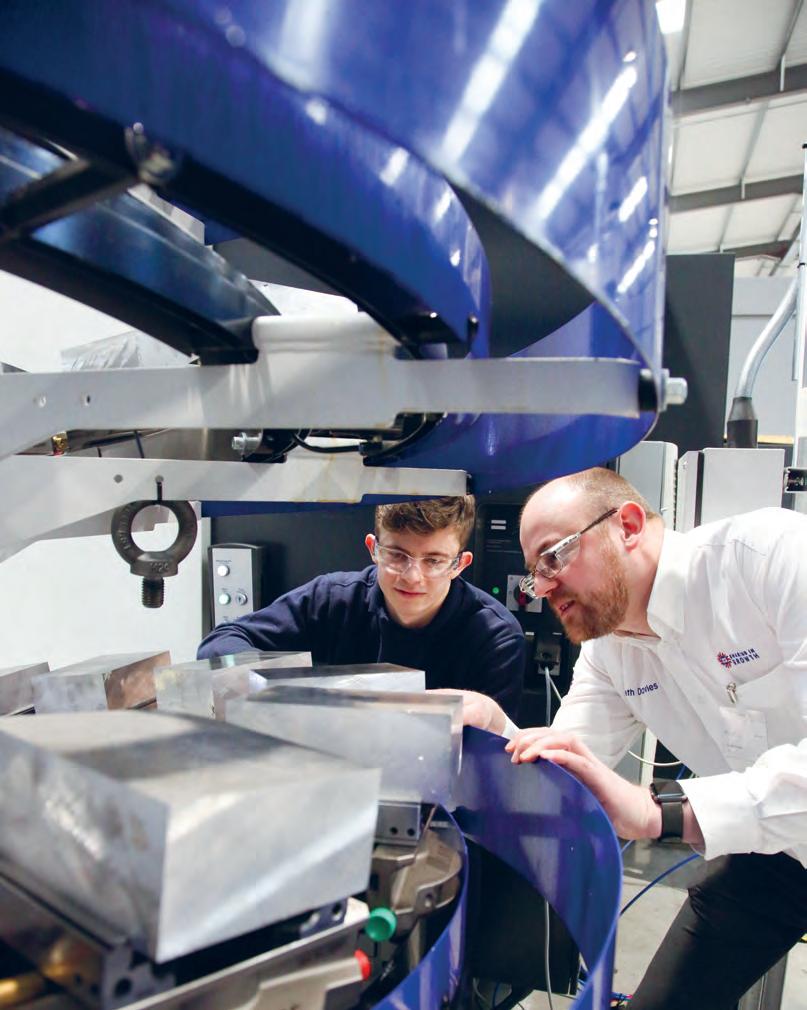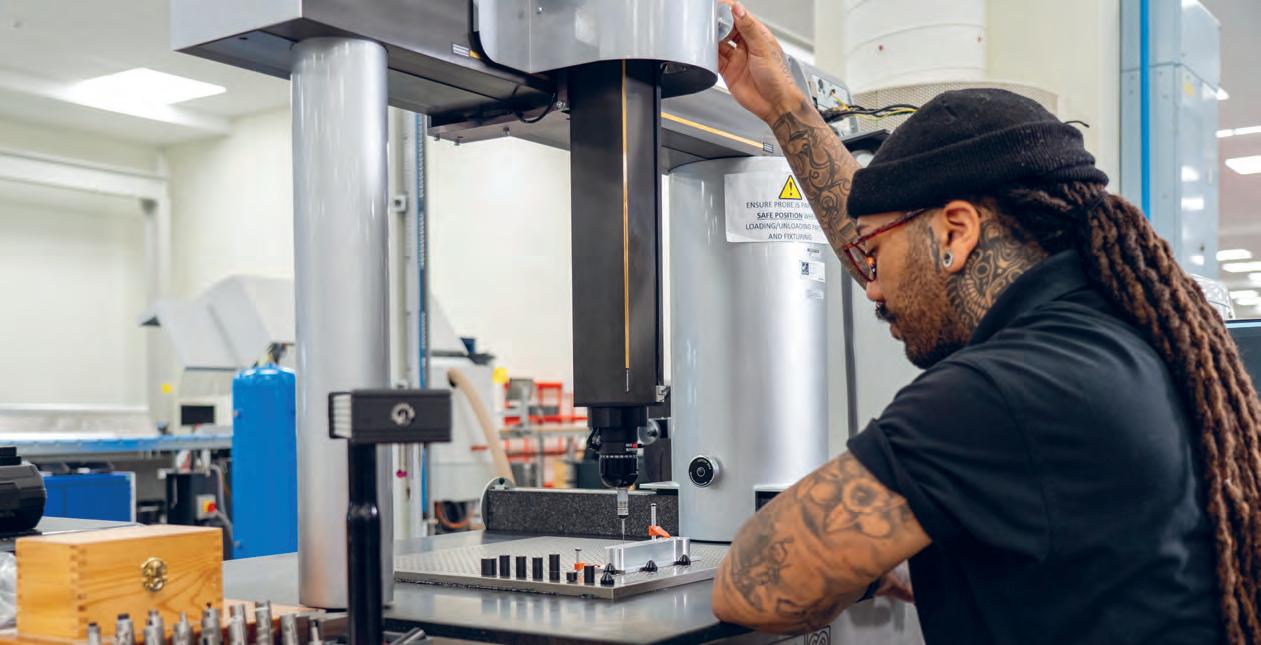
9 minute read
PIVOT PIONEERS
As runners up in The Manufacturer of the Year category at The Manufacturer MX (TMMX) Awards, you’d expect Druck to be an impressive business. Part of the global energy technology company, Baker Hughes, Druck designs, develops and manufactures pressure sensing devices and instruments, software and services.
The facility we visited at Groby in Leicester, is considered by Baker Hughes as something of a jewel in its crown, an advanced manufacturing and design centre of excellence. Like many facilities in the country, it suddenly appears out of nowhere. One minute you’re driving through a housing estate, next minute you’re at the gate; it almost rushes up out of the ground.
At this site pressure sensors are manufactured; very accurate, precise and stable products. These are typically used in harsh environments as well as in critical applications and in precise instrumentation across a variety of different applications.
A nice touch at this facility, is that every function is on display. All the way through from sourcing, manufacturing, purchasing, planning, marketing and product management. Employees can see how the products are made and the engineer who designs the product can see the full lifecycle, from the silicon to the sensor to the instrument – all the way through the supply chain.
These products are sold into a great number of different markets.
Dave Watson, who leads on Product Management, Marketing and Strategy explained: “We serve industries from aerospace, 50,000 feet in the air, to the bottom of the ocean in subsea markets and everything in between. We supply oil and gas topside, we supply power generation, semiconductors and we’re in the automotive industry.”
He continued, “We also supply the environmental monitoring spaces, which includes clean drinking water. The last glass of tap water that you drank was facilitated by Druck sensors in natural water monitoring and in reservoirs.
“We also have sensors in weather stations, monitoring barometric pressure measurement. The weather forecasts that you can get as an app on your phone are facilitated by Druck sensors.”
The products sold into aerospace include sensors that facilitate safe flight. They’re used in aircraft engines and environmental control systems. We can also thank Druck for the clean air that we breathe on commercial planes.
The issue though, is that some of these industries have taken a hit in recent years. So, how did the business turn this to its advantage?
Druck: a history
Before we get into more of that, let’s take a look at where the company started. Druck was established in 1972 by two creative entrepreneurs, Mike Bertioli and John Salmon. As innovative an engineer as he was a businessman, Mike was the inventor of the world's very first piezoresistive pressure sensor made from silicone back in the 1960s.
John was also an engineer, but as we were told by Druck Vice President,
Gordon Docherty, he was someone: “who really loved the customer aspects and the application.” Gordon went on to state: “I think when you’re starting up any business, having a great product and placing the customer in the market is a real recipe for success.”

Druck is the German word for pressure, and Mike and John chose this as the name for the business because of the association with German high quality and precision.

“Eighty percent of our products are industrial products,” explained Gordon. “And we have a class 100 cleanroom, where all our silicon chips are made.” It was in front of this cleanroom that we were chatting with Gordon, to a backdrop of laboratory engineers clad in blue protective clothing.
“As you'll see behind me,” gestured Gordon, “this is an example of our cleanroom where we produce over a million chips per year. Back in the day, Mike and John had a makeshift laboratory in Mike’s laundry room. We now have this multimillion-dollar investment that was put into the business to really increase the quality of our pressure sensor products.”
Last year, Mike and John called it quits, in a sale that valued Druck’s capital at £229m, of which they each picked up £58m. Not bad for two blokes who started out in a laundry room in Leicester.
Under pressure
We were led around the Druck facility (donning full, glorious PPE) and at various stop points were introduced to different people who gave us a broad insight into life at Druck. What we’re always eager to learn, is how UK manufacturers have navigated the last few years of unrest. Like so many in the sector, Druck has found solutions to the hardships.
As Gordon put it: “We've managed to really pivot.” A word we’ve heard so often. Druck was able to keep facilities open throughout the COVID-19 pandemic, both in the UK and in China. But, as a business supplying to aviation, this period caused some obvious challenges, meaning that Druck had to explore some alternatives.
“People weren’t flying on planes in great quantities, which of course saw the demand for pressure sensors reduce,” said Gordon. “We had to pivot into new markets and new industries. As the aviation industry was dipping, the semiconductor industry was really taking off. People wanted more computers, more phones and more tablets. People were working from home. And obviously, electric vehicle growth has been on the up more recently as well.”
He continued: “We’ve got a number of very strong pressure sensor products that we use in the semiconductor industry. We moved a lot of our products from aviation to industrial, and now we're seeing a real boom in our industrial portfolio. That’s been a real success for us.”
Druck has also felt the disruption of supply chains due to world issues, the conflict in Ukraine being an exacerbator. While it’s seen boosts in electrical and semiconductor markets, component supplies have been, and continue to be, widely reported issues in this sector. A lot of the metals that originate from those affected regions often go into the chips and the electronic components that Druck use.
This has been a task for Claire Aitchison to tackle, as it’s her responsibility to oversee supply chain management as Executive Operations Lead, and believes that despite the component shortages, the business has managed well. She puts this success down to having a world class sourcing team and a technology team that is well connected to Druck’s products.


“We've been able to find alternative components to use when they have been in short supply,” said Claire. “Our sourcing team has moved heaven and Earth to find pockets of components that have driven our ability to keep our lead times competitive.
She continued: “However, those solutions don’t come free of cost, and that’s been a real challenge to the business. Some of this we've had to pass on to our customers as price impact, and some of it we've had to absorb within the business. This has been the real impact for us from the hugely disrupted supply chains of the last few years.”
Don’t wait to automate
Gordon also cited further costs due to the ongoing conflict in Ukrainehyperinflation and rises in energy prices. In this instance, the business has tried hard not to pass this price rise onto its customers. “We can't do this,” Gordon stated. “As a result, we've had to invest in automation, and really looking at ways in which we can improve the productivity and efficiency of how we build products.”
Key Takeaways
• The high performance, high stability and high reliability element of Druck products make them suitable for a wide range of industries
• Clearly, investment in supply chain solutions has been substantial but needed to maintain competitive lead times
• Good employee engagement in sustainable initiatives only ever seems to lead to positive outcomes
• Druck was very nearly Manufacturer of the Year and almost took home Young Manufacturer of The Year at our TMMX Awards. Ones to watch this year, I suspect
Gordon again pointed to the cleanroom behind him, where lab coat-cladded personnel were busy about their work. “What we've got behind me is a good example of more automated processes. Previously, we used to inspect all our silicon chips manually using optical inspection products.
“Now, we've got automated optical inspection products, where we're using machine learning and artificial intelligence to inspect the chips. This is resulting in much higher quality and throughput. We’ve also moved several of our highly skilled operators, who would normally do that inspection, into other areas of our cleanroom to boost production there.”
In this situation, it’s clear that investment in automation was needed. Taking on initial cost for long-term benefits in production. Leila O’Shea, Advanced Manufacturing Engineering Manager at Druck, further highlighted the importance of automated, tech-centric processes.
“We produce hundreds of different variations and configurations of our silicon. Advanced automation within our silicon cleanroom has enabled us to triple our efficiencies through our silicon processing.”
She continued: “All of our processes are measured, monitored and data is captured. We have a team of process experts and engineers that will take that data and use the relevant tools to analyse it and look for continuous improvements.
“In doing this, we can look for quality improvement for our products, improved health and safety for our operators, efficiency in labour and capacity through our manufacturing lines. This in turn then gives
Entries for The Manufacturer MX (TMMX) Awards (in partnership with the Institution of Mechanical Engineers) are open now. Enter today. themanufacturermxawards.com our customers a repeatable and precision performance product that they need.”
The talent puzzle
The products that Druck manufacture, as already mentioned, are high precision. They require specialist engineers and there is little room for error for cleanroom technicians.
This begs the question then, where does the business find its skills for the present and the future? Particularly in an industrywide landscape of talent shortage.
Gordon pointed out, optimistically: “Druck has always had success in attracting strong talent to the business. We're very lucky that we've got highly talented, highly capable people that want to come and work for us.”
He continued: “I think our apprenticeship programme has been the platform for this recently. We work very closely with Loughborough College. Over the last few years, we've brought in a number of apprentices who have done exceptionally well. In fact, one of our apprentices, Jack Barnes, was nominated last year for Young Manufacturer of the Year at The Manufacturer MX (TMMX) awards.”
Druck also organises internships with universities; in its local area and globally the business allows students to undertake a year of work experience. While this is beneficial to the student, Gordon believes it elevates Druck as well, as he spoke glowingly about, “young minds that think up
BELOW: Druck has a class 100 cleanroom, where all its silicon chips are made new ideas and push us to think differently.”


Talent attraction is one part of the puzzle, talent retention is another. At its Leicester site, Druck has a number of long serving employees, but the 20+ years of service trend is one that businesses aren’t seeing as much of these days, with younger people more likely to change jobs.
In a bid to imbed talent by making them feel valued, the company has gone down the mentorship route. This involves pairing employees, some of them with 30-40 years of Druck experience under their belts, with younger members of staff.
Gordon explained: “This also drives the capability levels really high within the business. Although it's a global business, we really work as a family and as one team, and all of our people learn and grow together.
“I think this comes back to working at a facility where you’re able to see the entire lifecycle of the product - being built from the start, from the silicon to the sensor to the instrument. That really does build up a lot of excellent capability and knowledge of how we work.”
Push to net zero
Baker Hughes, the Druck parent company, has a vision to be net zero by 2050. Druck has set its own benchmark to halve its carbon footprint by 2030. This would indicate “a very active plan,” as Claire put it, on environmental progress. It’s a plan that Druck has been moving on since 2012.
“We understand our carbon footprint, we know the key drivers to reduce it and our usage of energy,” Claire explained.
“We have an active programme looking at energy usage, our machinery and our test procedures, which all use carbon dioxide and which we're looking to convert into a different gas.”
Claire also mentioned the importance of having good employee engagement when it comes to sustainability. She added: “It's not just about the hard-line business processes, our employees are passionate about the environment as well.
“We engage with our people; we have good recycling processes and, as a result, we've removed all single use plastics from the site. We’ve also changed all our lightbulbs for LEDs; all examples of those good ideas that come from people.”
Allowing people to do their part and feel involved in their company’s strategy is often seen as critical. Druck is taking this into account, as Claire explained it as being: “The corporate angle of really looking at our manufacturing process and making sure that’s on track to hit the company targets.”
Another shining exemplar
It feels like we’ve written similar conclusions in previous articles, but once again, we’ve spotlighted an example of real ingenuity in the face of turmoil. To transition into new markets so seamlessly is obviously easier when selling high quality products, but it’s the adaptation of Druck’s product positioning in relation to those different levels of market growth which is impressive.
Like many, it’s experienced the recent challenges around supply, but Druck has seen the opportunity for great growth potential and has seized it, by tapping into the rise in demand of semiconductors and the growth in chip demand through consumer electronics.
Here we have another UK manufacturer that didn’t falter through hard times, but strategically dragged itself into new markets to stay competitive and profitable, while retaining talent, investing smartly in automation and taking action on environmental goals.









